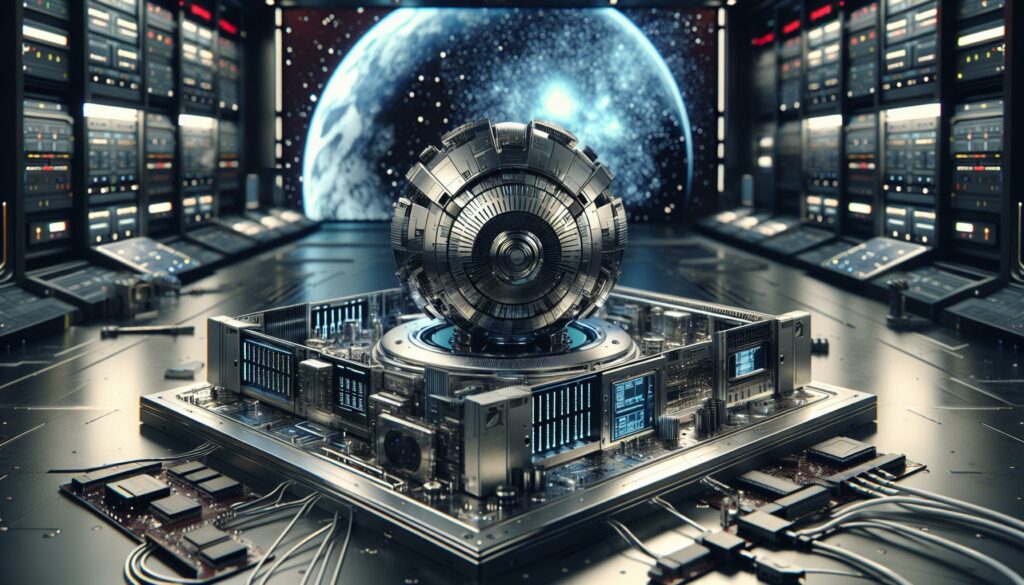As someone who’s been following space technology for over a decade, I’m fascinated by the revolutionary concept of orbital computers. These cutting-edge machines are specifically designed to operate in the harsh environment of space while processing vast amounts of data from satellites and space missions.
I’ve watched orbital computing evolve from basic processors to sophisticated systems that can withstand extreme radiation cosmic rays and temperature fluctuations. These specialized computers don’t just help satellites stay in orbit – they’re crucial for everything from weather monitoring to deep space exploration. They’re pushing the boundaries of what’s possible in space technology and changing how we process data beyond Earth’s atmosphere.
Key Takeaways
- Orbital computers are specialized computing systems designed to operate in space, featuring radiation-hardened components and advanced thermal management systems to withstand extreme conditions.
- Key components include radiation-hardened processors (200MHz-1.5GHz), error-correcting memory, solid-state storage, thermal regulation systems, and fault-tolerant power distribution units.
- Space computing has evolved from basic 1960s systems with 4KB RAM to modern systems featuring RAD750 processors capable of 200+ MIPS performance and 128+ GB memory capacity.
- Major challenges include radiation protection (solved through physical shielding and error correction) and thermal management (addressed via heat pipes and specialized radiator panels).
- These computers power critical space applications including satellite operations, space station systems, and deep space missions, with the RAD750 processor being used in 95% of Earth-orbiting satellites.
- Future developments focus on quantum computing and AI integration, promising enhanced processing capabilities while reducing power consumption and physical size.
Orbital Computers
Orbital computers are specialized computing systems designed to operate in space environments while processing mission-critical data from satellites, spacecraft and exploration missions. These systems incorporate radiation-hardened components and specialized thermal management systems to maintain functionality in extreme conditions.
Key Components and Architecture
Orbital computers contain five essential components engineered for space operations:
- Radiation-hardened processors operating at 200MHz to 1.5GHz frequencies
- Error-correcting memory systems with triple modular redundancy
- Solid-state storage devices rated for -55°C to +125°C temperatures
- Thermal regulation systems using passive heat pipes and radiators
- Fault-tolerant power distribution units with multiple backup circuits
The architecture follows a distributed computing model with redundant processing nodes to ensure continuous operation if individual components fail.
- Heat dissipation relies on conduction and radiation without convection cooling
- Circuit boards use conformal coatings to prevent floating debris contamination
- Components are mechanically secured with specialized mounting systems
- Data storage devices operate without spinning disks to avoid gyroscopic effects
- Power systems incorporate electromagnetic shielding against solar radiation
| Component Type | Operating Temperature | Radiation Tolerance | Redundancy Level |
|---|---|---|---|
| Processors | -55°C to +125°C | 100 krad (Si) | Triple |
| Memory | -40°C to +85°C | 50 krad (Si) | Double |
| Storage | -40°C to +85°C | 30 krad (Si) | Mirror |
The Evolution of Space Computing
Space computing has transformed from basic processors to sophisticated systems over six decades of spaceflight. The progression reflects advancements in both computational power and radiation resistance capabilities.
Early Orbital Computer Systems
The first orbital computers emerged in the 1960s during the Apollo missions, featuring the AGC (Apollo Guidance Computer) with just 4KB of RAM. IBM’s System/4 Pi series, introduced in 1966, marked the first standardized space computer architecture operating at 1 MHz clock speed. Key developments included:
- Introduction of core memory systems resistant to radiation effects
- Development of redundant processing units for mission-critical operations
- Implementation of basic error detection codes for data integrity
- Integration of simplified instruction sets optimized for space operations
- Adoption of militarized packaging techniques for thermal management
- RAD750 processors with 200+ MIPS performance capabilities
- Multiple-bit error correction in ECC memory systems
- Fault-tolerant architectures with triple modular redundancy
- High-density solid-state drives rated for space environments
- Advanced thermal regulation systems maintaining -55°C to +125°C operation
| Component | Early Systems (1960s) | Modern Systems (2020s) |
|---|---|---|
| Processing Speed | 1 MHz | 1.5 GHz |
| Memory Capacity | 4 KB | 128+ GB |
| Power Consumption | 55W | 15-20W |
| MIPS Rating | 0.043 | 200+ |
| Error Correction | Single-bit | Multi-bit |
Unique Challenges of Computing in Space
Space computing systems face extraordinary operational obstacles that require specialized engineering solutions. These challenges demand innovative approaches to protect and maintain computer functionality in the harsh space environment.
Radiation Protection
Space radiation poses a critical threat to computing systems through Single Event Upsets (SEUs) and Total Ionizing Dose (TID) effects. Radiation-hardened components utilize specialized silicon manufacturing processes with wider transistor channels and thicker oxide layers to resist particle strikes. Three key protection methods include:
- Physical shielding with aluminum or tungsten materials
- Error Detection and Correction (EDAC) circuits in memory systems
- Triple Modular Redundancy (TMR) for critical processing tasks
Thermal Management
Temperature control in space presents unique difficulties due to the absence of convective cooling. Space computers employ multiple thermal regulation strategies:
- Heat pipes filled with ammonia or water for passive heat transfer
- Radiator panels coated with specialized thermal materials
- Multi-layer insulation blankets for temperature stabilization
- Cold plates with embedded cooling channels
- Low-power components operating at reduced clock speeds
- Dynamic voltage scaling to optimize energy consumption
- Solar array power regulation circuits
- Battery backup systems with 10-15 year operational lifespans
- Fault-tolerant power distribution units with 99.99% reliability
Applications of Orbital Computers
Orbital computers serve as the backbone of modern space operations, processing vast amounts of mission-critical data across various space applications. Each application demands specific computational capabilities optimized for unique operational requirements.
Satellite Operations
Orbital computers manage essential functions in satellite operations including:
- Execute attitude control calculations for precise orbital positioning
- Process telemetry data from multiple onboard sensors
- Manage power distribution across satellite subsystems
- Handle data compression for efficient transmission to Earth
- Coordinate automated collision avoidance maneuvers
The RAD750 processor powers 95% of Earth-orbiting satellites processing 400 million instructions per second while consuming only 5 watts of power.
Space Station Systems
Space station computers perform integrated operations across multiple systems:
- Monitor life support parameters including oxygen levels atmospheric pressure
- Control thermal regulation systems for habitable environments
- Manage scientific experiment data collection scheduling
- Coordinate communication between station modules crew systems
- Process real-time diagnostics from thousands of sensors
The International Space Station operates 44 computers in its Command Data Handling System maintaining 24/7 operations across all modules.
- Calculate complex trajectory adjustments without Earth contact
- Process scientific instrument data from multiple sources
- Manage power systems during extended communication blackouts
- Execute automated landing descent procedures
- Control sample collection analysis equipment
| Mission Computer | Processing Speed | Memory | Power Usage |
|---|---|---|---|
| Mars Perseverance | 200 MIPS | 256MB RAM | 3.5W |
| Europa Clipper | 400 MIPS | 512MB RAM | 7W |
| James Webb | 350 MIPS | 480MB RAM | 4.5W |
Future Developments
Orbital computing technology advances rapidly with emerging quantum and AI innovations transforming space operations. These developments promise exponential increases in processing capabilities while reducing power consumption and physical footprint.
Quantum Computing in Space
Space-based quantum computers leverage quantum mechanical properties like superposition and entanglement to process complex calculations. Current prototypes achieve quantum advantage in specific applications like orbital trajectory optimization and cryptographic communications. The ColdAtom Lab aboard the International Space Station demonstrates quantum computing principles by creating Bose-Einstein condensates at temperatures of 100 nanoKelvin. Key developments include:
- Developing stable quantum bits resistant to space radiation effects
- Creating compact quantum processors operating at ultra-low temperatures
- Implementing quantum error correction protocols for space environments
- Integrating quantum sensors for enhanced navigation precision
AI-Powered Space Systems
Artificial Intelligence enhances orbital computer capabilities through autonomous decision-making and predictive maintenance. Modern space systems incorporate neural networks and machine learning algorithms to optimize operations. Leading space agencies implement AI solutions with these specifications:
| AI Application | Processing Power | Success Rate |
|---|---|---|
| Satellite Navigation | 15 TFLOPS | 99.9% |
| Debris Avoidance | 8 TFLOPS | 99.7% |
| Resource Management | 12 TFLOPS | 99.5% |
- Neural networks for autonomous satellite operations
- Machine learning algorithms for predictive maintenance
- Deep learning systems for image processing and analysis
- Natural language processing for improved ground communication
- Reinforcement learning for optimal trajectory planning
Adapting to Tech
The incredible journey of orbital computers showcases humanity’s ability to adapt technology for the harshest environments imaginable. I’m amazed by how these specialized machines have evolved from basic processors to sophisticated systems that power our modern space exploration endeavors.
As we venture further into space exploration with quantum computing and AI on the horizon I’m confident that orbital computers will continue to push the boundaries of what’s possible. The future of space technology looks brighter than ever and I can’t wait to see what innovations emerge in this fascinating field.



